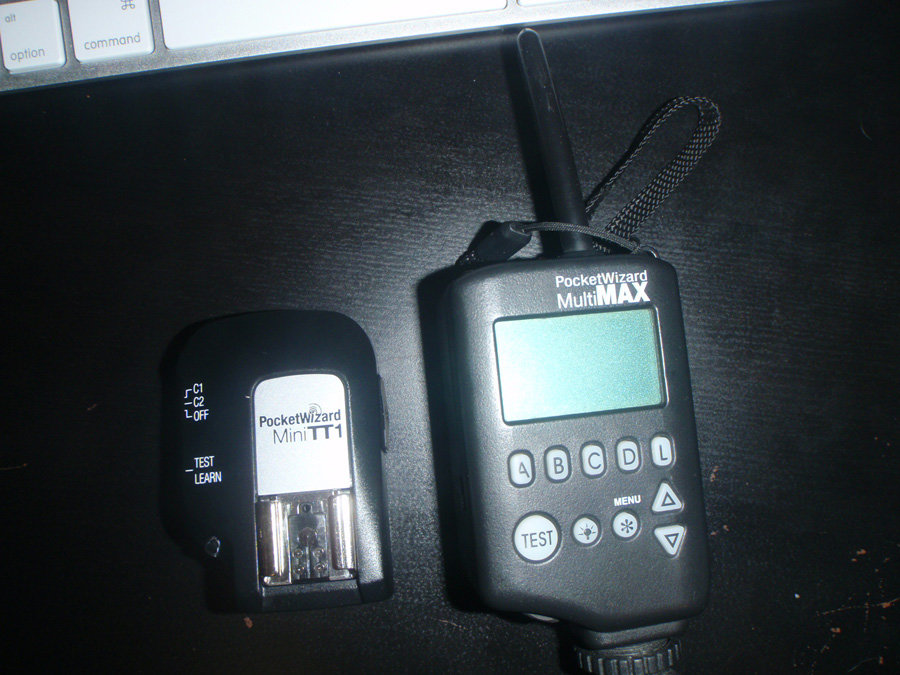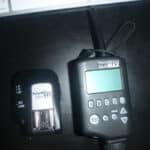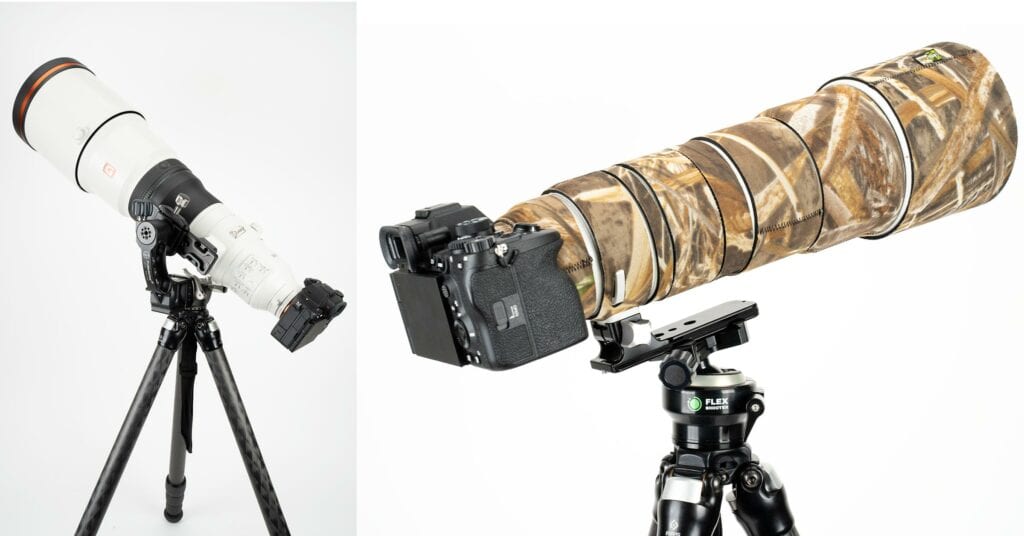Be prepared… this is a long one.
A few months ago I wrote a post HERE about a couple of exciting new products from LPA designs, the makers of the pocketwizard triggering system. If you are entirely unfamiliar with these products i suggest a quick read of my earlier post as there is a bit of assumed knowledge.
I’m not initially interested in the wireless ETTL modes for these new models so i just bought myself a TT1 transmitter to try out the Hypersync mode which supposedly allows you to achieve a much higher x-sync with your strobes. Unfortunately I experienced a deluge of problems and they were so many that there is no way my problems were isolated, if anyone from LPA designs reads this it would be nice to get some sort of formal response to my issues. If there is a solution/fix on the way I would love to know about it.
Where to begin??……
In this photo you can see a size comparison with the pocketwizard Multimax. The TT1 is refreshingly small thanks mainly to the smaller battery and lack of screen. The vertical orientation of the older PWs left them susceptible to hotshoe damage. I have snapped off several hotshoes on the older ones with only minimal force. The slimline TT1 should be much stronger and the lack of external aerial means you can more easily stash it in the smallest corner of your camera bag. This I like very much!
Buttons are few and far between. There is a test button and a small switch with three settings, OFF, C1, C2. The C1 and C2 switch allows you to select one of two totally different setups which are configurable by using the USB cable and supplied computer software. Each setup can have its own channel (1-32) and its own hypersync offset value as well as a couple of other ETTL settings. If for example you use 2 different cameras, you might want to have each configuration tailored to to each camera. Or if you use two types of strobes like I do (speedlights and Elinchrom Rangers) you can use each config. for each type of strobe. So what do you do if you use 2 cameras and 2 types of flashes hence requiring 4 configurations? The key problem here is that the Hypersync offset (which i will explain in a bit) is different for every type of flash and every camera. For me, 2 configurations is simply not enough. Would it have been hard to implement a 4 way switch instead? And speaking of which, the switch itself is one of the cheapest switches I have ever had the miss-fortune to pay a couple of hundred dollars to use. It is so small and flimsy that it is actually quite difficult to get it into the C2 position because the throw of the switch is so small. It also wobbles around like its about to fall out.
Unlike previous PWs , there is no way to change the channel on the transmitter with a simple switch. You have the option of using the c1 and c2 switch but that only gives you 2 channel choices and I found that i preferred to have both c1 and c2 set on the same channel and instead have the hypersync offset values set differently on the 2 settings. One for my 1dMKIIN and on for my 5dMKII. For most people this probably wont be a problem, when you plug the TT1 into a computer you can alter the channel that way. If you come across another photographer in the field though and you are both using the same channel there is a way round it. LPA designs have included a learn function in the TT1. By using another transmitter or transceiver you can teach the TT1 any of the 32 standard PW channels by simply holding the learn button and firing the test button on the second transmitter in close proximity. Of course this relies on you having either a PW Multimax or a PW PLUS II to teach the channel. In practice I found this to work very well and very quickly. I think i appreciate the size saving by not having to have a screen in order to select the 32 channels. I’m sure it was a cost saver too. See, I’m trying to stay positive about some of this!
I shoot with a Canon 5dMKII which has a x-sync of 1/200. Something that was talked about heavily upon its release and considered by many to be the biggest negative against the camera. I know several sports photogs that avoided it because of this fact alone. I have put up with it but it does limit the cameras potential when you are shooting outdoor action with strobes in bright sunlight. 1/200 is just not fast enough. So when I heard about the hypersync mode in the new TT1 I was very excited. It claimed to be able to take my x-sync on my 5dMKII up to 1/320 which is what I always use on my 1DMKIIN. If this was true it would be a BIG deal to me.
So what is Hypersync? Well I’m not going to go into great details because this is going to be a long enough post anyway. Basically the TT1 is able to send the trigger signal to the flash before the shutter operation has begun on the camera. Getting this jump on the tightly timed proceedings of x-sync and shutter operation allows you to squeeze a slightly faster x-sync out of the camera because the flash is already well on its way to firing as the shutter opens. The “head start” that you give the flash burst is called the hypersync offset and it is controlled in very small increments using the software. There is no easy way to figure out which offset value is going to be the best for your setup. The best way to do it is to aim your flash at a blank wall and experiment with different shutter speeds and offsets. You will see a dark band on your photos if you set the shutter speed too fast and your aim is to get the fastest shutter you can with the most minimal amount of black banding. This trial and error process is extremely frustrating, especially because you have to remove the PW from the camera and connect it to your computer in order to change the offset. The whole process is made even more frustrating by the inconstancy of the results. Whenever you change the offset , i quickly learn t that the first shot you take will be junk. For whatever reason , you need to fire one shot off before the PW will give you more consistent results. The first shot every time would always give me a totally different result so ignore that one. I also found that sometimes it would simply not fire at all for the first few times. The receiver was no more than a foot away and sometimes I would have to fire 5 or 6 shots before the TT1 would begin to send a signal.
More inconsistency…..
When i first got the TT1 i immediately put it on my 5dMKII. I had heard you could get it to work at 1/320 with almost no banding in the frame. I tried it with the default settings and default offset value of-170. Much to my surprise i got a totally clean 1/320. No banding whatsoever. I was very excited about this but when i went back to the TT1 the next day and put the setting back to those that I had used the day before i started to get banding at the bottom of the frame. I thought i was going mad, i went back and checked my shots from the day before. Sure enough, 1/320 with no banding. I began going through the whole trial and error again thinking that I must have used a different offset but after 45 minutes of frustration I could not improve on the result I was getting. Granted, the banding was minimal, probably only 1/20th of the hole frame but it still frustrated me that I could not repeat the result from the day before.
I began to try some higher shutter speeds up to 1/640 just to see how much of the frame was going to be black. Now remember when I was saying how the first shot after you unplug from your computer is junk? Well I found that if i set my shutter speed to 1/500 , I could achieve a totally clean shot for the first shot. 1/500 x-sync on a 5dMKII?! That is crazy, but it would only work once, immediately after I unplugged from the computer. And then after that the best I could get would be 1/320 with a small amount of banding. At first I was excited by the 1/500 result. I knew it was possible on my 1DMKIIN as I had already seen consistent results from that, but the 5dMkII was normally much slower. So why does it work just once? If it works once, surely there is a way to get it to work all the time? I spend the next hour trying different offset values but to no avail. By this time I had dedicated about 4 of the most frustrating hours of my life to trying to configure these things and I was about ready to throw the thing at the wall. Yes I can achieve a faster x-sync than before but the whole implementation of it was driving me mad.
The TT1 just seemed to be a totally different POS on the second day. When i first got it, the first shot after unplugging from the computer always displayed black banding for the bottom half of the frame. With that one out of the way it would do pretty much what it was supposed to. But on the second day of configuration, that first shot after unplugging from the computer would always show a perfect photo even, as I said at much higher x-sync that you would imagine possible. These simple inconsistencies just make you think this is a product that was just not ready for public consumption yet and gives you zero confidence that it will work as you want it to next time you pull it out of you camera bag. I can’t comment on the ETTL capabilities but it seems like they should have waited a lot longer before putting this product out there.
Next problem, mixing strobes.
Different offset values are needed for different strobes. If you have a mixture of strobes in your setup you are not going to be able to get the best out of this transmitter. I found that the best offset value for my canon speedlight 580EX and my Nikon SB-80DXs were quite close. Not too much to worry about and if i picked an average offset value for the two I could achieve good results. Not quite as good as if they were all Nikon or all Canon, but decent. The big problem come when you mix in a large studio strobe such as my Elinchrom Ranger. The best offset for the speedlights and the Ranger were a long way apart, the ranger needing much larger offset. This just causes a mess of uneven lighting which is totally useless for anything.
Oh and did I mention that the optimal offset for each flash is also different for different power settings? Not by much in most cases but its something else to be wary of (and frustrated with). With only 2 possible settings (c1 and c2) available to you on a shoot. You need to know what power you plan to use, which camera and which combination of strobes. Not very flexible unless your client is willing to sit there while you try to trial and error a new offset value……
While doing all of this preliminary testing at my home ,another bug popped up. Because the hot shoe of the TT1 mimics that of a canon speedlight, the camera thinks there is one in the shoe and would therefore love to limit you to whatever the native x-sync is (1DMKII is 1/250 , 5dMKII is 1/200). In order for you to select a higher shutter speed, the TT1 tricks the camera into thinking you have a flash with High Speed sync enabled. The small “H” symbol appears in the viewfinder to show this But occasionally when i would take a test shot, this would not work and the shutter speed I selected on the camera would flash back to 1/250 at the instant i took the shot. I could never figure out what was making this happen. It didn’t happen all that often but it does not inspire any confidence in the product. If I am shooting an athlete doing something , I NEED to know that it is going to behave in a repeatable fashion. I cant just cross my fingers and hope that it doesn’t freak out when i press the shutter and select 1/250 when i want 1/500. The shot would be ruined.
TT1 in real life use…..
Ok time to get out of my house and put this thing to use in a real situation. Maybe the results would wash the sour taste out of my mouth.
For those of you who have ever used pocketwizards to shoot skiing and snowboarding, you will probably know the frustration of your flashes not firing when you are 50 yards away with line of sight to the receiver. We all know that the stated maximum range of these things is 1500 feet with optimal conditions. These optimal conditions only exist in the labs at LPA designs.My flashes regularly fail to fire at anything more than 50 feet away and sometimes even less. There are many ways to improve your chances of getting signal, raise the receiver off the ground and keep it away from metal are two of them. This past weekend while shooting a jump for a sunset ski shoot, I placed my receiver on top of a 12ft light stand on a wooden bracket. I then moved the lightstand so that it was directly in front of me and about 40feet away. I ran a long cable from the receiver to my strobe which was slightly hidden from me. The receiver though was plainly visible and raised well above the ground. My flash only fired about 2/3 of the times I wanted it to when i used the TT1 as my transmitter. FROM 40 FEET AWAY WITH DIRECT LINE OF SIGHT. When i held the camera in landscape orientation I would get much better results, but turn it 90 degrees for a portrait shot and it would fire 50% of the time at best. Sometime it would fire if i held it 5 inches from my face, but put my eye up to the viewfinder and……NOTHING. Now some of these weird shortcomings are things I have experienced using the PLUSII and the Multimax. But i was really hoping that the TT1 would have addressed some of these issues and it has not. In fact, it was worse. I took the thing off my camera and went back to using a Multimax for the rest of the shoot.
I know several people who have had shoots entirely ruined by the poor range on PWs and the inconsistency of the signal and I really thought that they would have made some headway by now. The problem is that the majority of PW users use them in such close proximity that they never have a problem. Or they use them in a stadium or basketball court where signals seem to work quite well for some reason. Perhaps the signal is bounced around much more. I think its time that LPAdesigns addressed some of these signal issues as well as the ones i mentioned above regarding the TT1. If you have had problems with PWs and have had a shoot ruined by one I would urge you to make a comment on this post below and hopefully someone from LPA designs will read it. I will be sending this post to them and asking if they have any suggestions for solving some of the problems and I will post a response if one comes.
The simple fact right now is that there is no way I would recommend this TT1 to anyone who is working professionally. If you are not relying on your photography to make your living then maybe you wont mind the trial and error that comes with it. If you have clients relying on you though and you have a reputation to uphold, there is no way I would trust this thing if you plan to use it in a similar fashion to me. I have had enough trouble with the PLUSII and multimax, I don’t need any more problems. Yes I could get a 1/500 x-sync on my 1DMKIIN and 1/320 on my 5DMKII but the limitations on configuration and inconsistent operation just make it far to much hassle and it feels like you are rolling the dice every time you take a shot.
If you do buy one, wrap it in some foam and duct tape so it bounces when you throw it against the wall.
UPDATE: Cameron Laird is a news photographer from Australia and he has published a great video about his problems with the ETTL side of things when using the TT1 and TT5. Whilst I did not test that side of things, it would seem that it too is well below an aceptable level of reliability for a product as expensive as this. Watch the video HERE. Visit Cam’s blog HERE
UPDATE2: I mentioned above that the quality of the on/off switch was terrible. I failed to mention that the quality and feel of the Test button is also unbelievably sub-par. Today I took my collection of pocketwizards out to an open field to do some range testing just to see how poor these things are in a more suitable environment. After pressing the test button no more than 50 times, it has now broken. The button is stuck on. Holding down the test button puts the TT1 into “learn” mode so my transmitter is now permanently stuck in that mode and will not function.
Before it broke, my estimate was that the useable range of it was around 30 feet in direct line of site. Anything more than that was a crap-shoot. I did squeeze a tiny bit more range out of it when i hoisted the receiver up on top of a 15foot lightstand but lets be honest, we dont want to have to do that all the time. Imagine having to have 2 lightstands for every light. The receiver should not require its own lightstand!!!! Let alone one that is 15 feet tall.
Please Pocketwiard, if you are listening, lets get these things fixed! They have the potential to revolutionize flash photography but they really need some work right now to iron out the bugs!!




